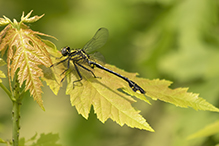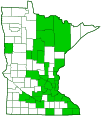cobra clubtail
(Gomphurus vastus)
Conservation • Description • Habitat • Ecology • Distribution • Taxonomy
Conservation Status |
|
|||||||
| IUCN Red List | LC - Least Concern |
|||||||
| NatureServe | N5 - Secure SNR - Unranked |
|||||||
| Minnesota | not listed |
|||||||
Description |
||
Cobra clubtail is a fairly common, medium-sized, semi-aquatic dragonfly. It occurs in the United States east of the Great Plains and in adjacent Canadian provinces. It is found at large rivers with moderate to rapid current, and occasionally at large streams and large, rock-bordered lakes. In Minnesota it occurs along the major rivers, including the Rainy, Red, St. Croix, Mississippi, Minnesota, and Cannon Rivers. Adults are active from late May to early August. They perch on the shoreline on shrubs, rocks, or sand. Adults are 1⅞″ to 2¼″ (47 to 57 mm) in length and have a 2⅝″ (66 mm) wingspan. The body is black with pale yellow to greenish markings. The head is small. The face is yellow with a heavy horizontal black stripe. The large compound eyes do not meet at the top of the head. They are bright green in direct sunlight but appear gray in the shade. The area behind the compound eyes at the top of the head (occiput) on both sexes is yellow. The thorax is black with yellow or greenish (pale) stripes on top and on the sides. On young adults the markings are bright yellow. As the dragonfly ages the thoracic markings fade to a dull grayish-green. The pale stripes on top (dorsal stripes) of the thorax are as wide as the black stripes. They are joined at right angles in front forming a rearward-facing U pattern. There is a narrow stripe in the shoulder area that connects at the rear to the dorsal stripe. The sides of the thorax are pale with two narrow, usually unbroken, black stripes. The abdomen is slender and black with pale markings. It is very narrow from segments 3 through 6, then expands into a noticeable “club” on segments 7, 8, and 9. The club is broad and is said to resemble a cobra’s hood. This is the feature that gives the species its common name. The upper (dorsal) surface of abdominal segments 1 through 7 have yellow, elongated, triangular spots. The spots of segments 3 through 6 are thin. The spot on segment 7 is broader and short. There are no dorsal spots on segments 8 through 10. There is a bright yellow spot on each side of segments 8 and 9. The lateral spot on segment 8 is small and does not reach the lower edge of the club. On some individuals it may be tiny or absent. The lateral spot on segment 9 is much larger, spanning the entire margin and reaching the lower edge. Unlike the other pale markings, the color of the lateral spots does not fade with age. At the tip of segment 10 the male has a pair of distinctive, widely forked claspers (cerci). The legs are black. The wings are clear except for a yellow tinge on the basal quarter and a dark cell (stigma) on the leading edge near the tip. |
||
Size |
||
Total length: 1⅞″ to 2¼″ (47 to 57 mm) Wingspan: 2⅝″ (66 mm) |
||
Similar Species |
||
Habitat |
||
Large rivers and streams and large lakes |
||
Ecology |
||
Season |
||
Late May to early August |
||
Behavior |
||
Adults perch on the shoreline on shrubs, rocks, or sand. |
||
Life Cycle |
||
|
||
Naiad Food |
||
|
||
Adult Food |
||
|
||
Distribution |
||||
|
Sources Haarstad, J. 1997. The dragonflies of selected eastern Minnesota rivers. Report submitted to the Minnesota Department of Natural Resources. Unpaged. |
|||
| 6/18/2022 | ||||
Occurrence |
||||
Fairly common |
||||
Taxonomy |
|||
Order |
Odonata (Dragonflies and Damselflies) | ||
| Suborder | Anisoptera (Dragonflies) | ||
Superfamily |
Aeshnoidea | ||
Family |
Gomphidae (clubtails) | ||
Genus |
Gomphurus | ||
This species was formerly classified as Gomphus vastus. In an attempt to clarify the relationships of species in the genus Gomphus (Needham, 1947) , five subgenera were proposed. This species was placed in the subgenus Gomphurus. In later years, several other subgenera were defined. Nine of the genera were grouped in what was called the Gomphus complex. A recent phylogenetic analysis (Ware, et al., 2017) raised all nine subgenera in the complex to genus level, and Gomphus vastus became Gomphurus vastus. |
|||
Synonyms |
|||
Gomphus vastus |
|||
Common Names |
|||
cobra clubtail |
|||
Glossary
Cercus
One of a pair of small sensory appendages at the end of the abdomen of many insects and other arthropods. In Odonata, one of the upper claspers. Plural: cerci.
Occiput
The back of the head. In Odonata, Megaloptera, and Neuroptera, the upper part of the head behind the eyes.
Stigma
In plants, the portion of the female part of the flower that is receptive to pollen. In Lepidoptera, an area of specialized scent scales on the forewing of some skippers, hairstreaks, and moths. In other insects, a thickened, dark, or opaque cell on the leading edge of the wing.
Visitor Photos |
|||||
Share your photo of this insect. |
|||||
| This button not working for you? Simply email us at info@MinnesotaSeasons.com. Attach one or more photos and, if you like, a caption. |
|||||
Greg Watson |
|||||
 |
|||||
MinnesotaSeasons.com Photos |
|||||
|
|||||

Slideshows |
||

Visitor Videos |
|||
Share your video of this insect. |
|||
| This button not working for you? Simply email us at info@MinnesotaSeasons.com. Attach a video, a YouTube link, or a cloud storage link. |
|||
Other Videos |
|||
| Cobra Clubtail - Gomphus vastus Stoil Ivanov |
|||
About
Jul 7, 2014 Cobra Clubtail ( Gomphus vastus ) Kankakee River State Park, Kankakee County, IL 7-06-2014 |
|||
| Mondays with Martha #54 - Cobra Clubtail Dragonfly Nature Niche |
|||
About
May 31, 2021 This week I share a striking dragonfly that I found in my birdbath, the Cobra Clubtail. Learn about this species and its dependence on high quality riparian habitats. Hope you have a lovely Memorial Day and get outside to see some dragonflies! |
|||

Created: 6/18/2022
Last Updated:


